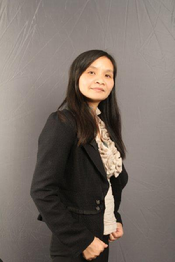Spintronics using C60 fullerenes: Interface and devices
Promotion date: December 4.
Promotor: Prof.dr.ir. Wilfred van der Wiel
Assistant promotor: Dr.ir. Michel de Jong
| Carbon-based materials are promising for spintronic applications due to the weak spin-orbit coupling in these materials, potentially providing a long spin life time. An additional advantage is that organic materials exhibit non-critical requirements for high quality interface formation and film growth on various substrates. This research focuses on spin polarized transport through thin films of C60 fullerene molecules in vertical spin valves, spin polarized hybridization effects at C60/bcc-Fe(001) interfaces, and the ordering of C60 molecules on epitaxial bcc-Fe(001) thin films. The spin polarized transport in C60-based spin valves, was studied by both experiments and modelling. The junction magnetoresistance is shown to drop as the amount of intermediate tunnelling steps increases, regardless of the spin lifetime and spin diffusion length. The electronic and magnetic properties of the interface between C60 molecules and a Fe(001) surface are described. Photoemission spectroscopy (PES) and C K-edge X-ray absorption spectroscopy (XAS) show charge transfer from the Fe substrate to C60 molecules, and strong interfacial bonding between C60 and Fe (in case of a monolayer C60 on Fe). The potential of chemical tuning of organic semiconductor / ferromagnetic “spinterface” for spintronic devices is underlined. A combined computational (density functional theory) and experimental (XMCD) study on the magnetic properties of interfaces between bcc-Fe(001) and C60 molecules is presented, using X-ray diffraction (XRD) and scanning tunneling microscopy (STM). In conclusion spin polarized transport in C60-based vertical spin valves and the magnetic polarization at C60/ferromagnetic interfaces was studied. Significant understanding of the physics of C60-based vertical spin valves has been generated, however certain aspects such as the determination of spin relaxation length and -time require further study. The realization of well-defined interfaces in devices is required to fulfill the potential of organic/carbon based materials for spintronic applications. |
Was your thesis work fundamental in nature or also application oriented?
Organic semiconductors have potential to be used in electronic devices such as mobile phones, digital cameras, and in next generation computing technology, especially now further reduction in size of devices is reaching new boundaries and challenges. The organic semiconductors are flexible, cheap and widely available. Also advantages are present for fabrication and synthesis techniques.
However, unlike inorganic semiconductors, no fully operable magnetoresistive random access memories (MRAM’s) are operable, as functioning at low temperatures is favorable and many aspects of the physics involved are not clear yet. Some main differences appear here, like the hopping transport between localized states (molecular orbitals) in organic semiconductors and charge transport from delocalized states(bands) in inorganic semiconductors.
My research was on the exploring part, trying to fabricate, characterize and measure essential effects that will be crucial in future applications. We fabricated the spin valves, characterized their properties by performing both measurements and modeling. A vertical spin valve using C60 molecules has been fabricated successfully and showed significant magnetoresitance behavior at room temperature. We showed magnetoresistance decreases due to multi-step tunneling, even when there is no spin relaxation. Also characterizations on ferromagnet/C60 interface properties were a central theme in my work.
There were two important moments I recall during my PhD period. I showed that the well-defined interfaces can improve the magnetoresistive effect in organic spintronic devices, which is crucial . Also important the clean: well-characterized and structurally ordered hybrid interfaces help to understand on novel physics at the junctions.
In what journals and magazines were your findings published?
The multistep device bit was published in Advanced Functional Materials and the interface story in Applied Physical Letters. Also publications appeared in: ACS Applied Materials and Interfaces, Org Electronics and in STW magazines.
In what way did you develop personally, as a researcher and scientist?
I developed my experimental skills and my cleanroom fabrication techniques a great deal, varying from thin films production unto complete multistep devices. The procedures were very time consuming at the beginning of my thesis work, now I know how to optimize the fabrication steps involved.
Comparing to four years ago I gained lots of knowledge on academic level, especially on organic spintronics. Last but not least, my presentation and communicating skills improved by writing and editing articles, visiting conferences, communicating and collaborating with colleagues.
What are your future plans?
Right now I am applying for jobs both in academics as well as in industry. I guess larger companies in which interface technology is an important issue, be it organic or inorganic, are of interest to me. I would like to work closer to the needs of the customer in future.
Did you benefit by being part of the Mesa+ institute?
We collaborated successfully with the Inorganic Materials Science Group on X-ray diffraction measurements, etc. Also we collaborated with the Computational Materials Science Group, led by professor Paul Kelly, helping us to perform complex calculations on our data.
Besides, we collaborated with Linkoping and Lund University in Sweden. During my thesis work, I performed measurements at the powerful synchrotron radiation facility in Max Lab, Lund University. Collaboration with the universities and institutes does proceed smoothly, as Mesa+ is renowned institute all over the world.
The facilities and kind collaboration with experts at Mesa+ was great. Perhaps some more daily support for foreign PhD students would make the talent coming to Twente even more productive, I believe.

